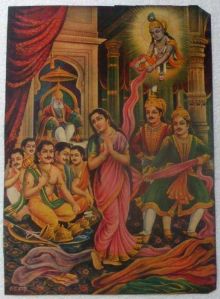
Though the legal aspect resounded completely, the moral one fell short in one aspect – If she could be won at a contest, so could she be lost, taking into cognizance the prevalent customs of those times.But a lady who could stand up and ask this question in the face of dire adversity indicated courage,clear thinking and a will to preserve her dignity at any cost. It could only point to a trait of boldness above all else.
Therefore, it came something as a surprise when I read a completely different interpretation by Iravati Karve, of the very same incident. Quoting from her book, she says..
“Draupadi’s question was not only foolish, it was terrible. No matter what answer was given, her position was desperate.If Bhishma told her that her husband’s rights over her did not cease, that even though he became a slave, she was in his power and he had the right to stake her, her slavery would have been confirmed. If Bhishma had argued that because of her slavery, her husband had no more rights over her, then her plight would have been truly pitiable… She had made many mistakes in her life that were forgivable, but by putting on airs in front of the whole assembly, she had put Dharma into a dilemma and insulted him…Though she was only a young bride of the house, she had spoken in an assembly of men, something she should have known she must not do.Over and above, to pretend that she could understand questions that baffled her elders – that was inexcusable arrogance.”
She further espouses that instead of arguing about the legal technicalities like a lady pundit, she should have cried out for decency and pity in the name of the Kshatriya code. Had she done so perhaps things would not have gone so far.
There are some definite points which struck me – Draupadi had the guts to speak in an assembly of men and elders who might have been more learned than her but who were also prepared at that point of time, to be mute spectators to her humiliation. To think, that at a moment of adversity such as this, a woman would have the capacity to put on airs instead of focusing on using all weapons at hand to defend herself, is also casting an unjust aspersion on her.Though there are sexist connotations and it abounds in far too many patriarchal interpretations for my liking, I had to acknowledge there are facets which are interesting and deserve further thought.
In the face of adversity, which one should a person rely on – Courage or Practicality ? Is a courage;which is guaranteed to lead one to failure, only false bravado. Is practicality which dictates a person to appear weak and grovel, more worthwhile if it guarantees success.Will the ‘success’ earned in this manner be devoid of shame.
Everyday, there are enough and more instances, wherein this question finds its way into conscious thought. There are innumerable cases of victims of rape, some who lose their lives as well and some who fortunately survive to tell their tale. In those darkened alleys and corners, when terror strikes, the question of courage versus practicality would haunt the person who faces it. For all we know, their choice may not have mattered and affected their ultimate fate, but yet again, it could have.
In historical times, there have been enough tales of courage and valor. The story of Chittorgarh is worth remembering in this context.Though the women sacrificed their lives for saving their honor, an idea which can be disputed in the current world context, its a story of courage nonetheless. Was it a story of success or failure or would it be too naive to bracket it so narrowly.In today’s context, there was a case of a woman attacked at an Bangalore ATM. The fact that she resisted a machete wielding man and refused to hand over the money was almost laughable to me.Being practical was a clear winner there. But there are more gory cases of rape which at times lead to murder, some of whom bring forth the question – could the victim have saved herself by being practical.
The importance of Draupadi’s question would find no relevance for an audience which lacks the will and the power to arrive at the right answer.The fact that she asked the question also shows that she reposed faith in their moral dharma and their system of governance even though her faith was later proved to be misplaced.In today’s world, there will be no divine intervention when a woman is being disrobed. It will be entirely upto the woman to keep her wits about herself and figure out the answer to Draupadi’s dilemma.
















